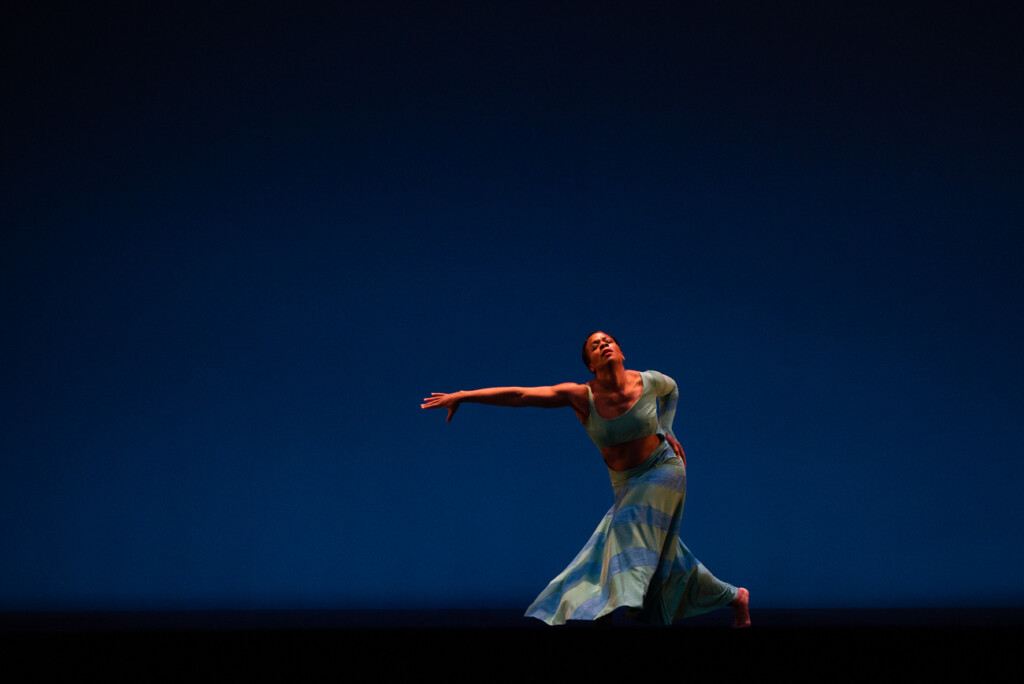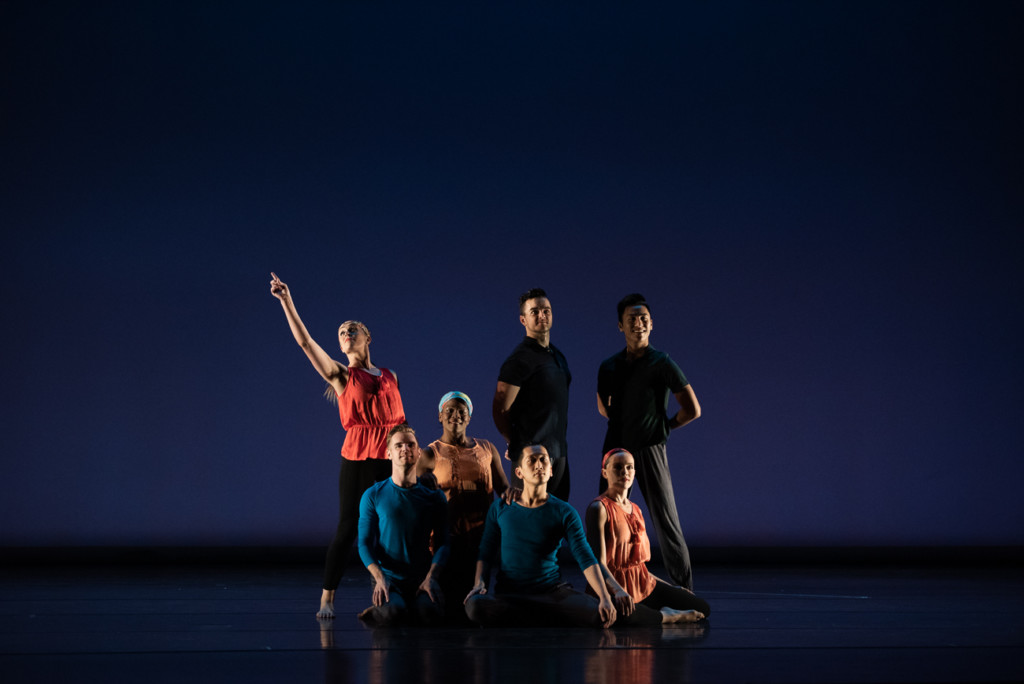Two of Salt Lake City’s internationally known dance institutions return to the Utah Arts Festival stage this year.
REPERTORY DANCE THEATRE (June 25, 5 p.m., Festival Stage)
Repertory Dance Theatre (RDT) holds a special distinction in the history of the Utah Arts Festival. The historic contemporary dance institution has performed in every festival, save one (when the company was on tour). Ahead of its 58th season where the theme will be “Celebrating Community,” Linda C. Smith, RDT’s co-founder and executive artistic director, says that for this year’s festival performance, the emphasis will be on that RDT has become far more than their core of eight dancers. This includes initiatives such as its school lecture and demonstration programs, its Link Series, its dance center and presence in Dance Church, Music in Motion and other programs for creative aging, along with its contributions to the Ring Around the Rose program at the Rose Wagner Center for Performing Arts.
The UAF performance will include a revival of Fin Amours by Susan Hadley, which RDT premiered 20 years ago. Hadley choreographed a new take on the pas de deux by switching around traditional roles. There are nine duets and the dancers in each pair have equal roles in their physical execution, emotional contouring and expressions of wit and exuberance. The dance movement arises from simple themes and immediately recognizable gestures. “It’s the ideal opener to help demystify the idea of contemporary dance for audiences who otherwise feel somewhat intimated by trying to figure out the meaning of a work,” Smith explains.

Highlighting that dance can be an active lifelong pursuit, RDT will have participating performers, who are 55 and older, from their just completed Prime Performance 2023 workshop. Led by teaching and dance artist Meghan Durham Wall, the workshop includes performing opportunities at UAF as well as one of the company’s concerts, in November this year. The workshop was open to older adults, regardless of whether or not they had prior dance experience.
RDT also will feature 40 dancers from a Utah Valley University workshop in a new work called Escrow, which Elle Johansen choreographed. The program was coordinated by Angela Banchero-Kelleher, an RDT alumni dancer and UVU professor.
RDT also will present two shorter works from recent seasons. The first is Ursula Perry’s solo in Donald McKayle’s 2005 work I’ve Known Rivers, which The Utah Review previously described as brilliant in every beat of movement and verse. The work augments but, more importantly, magnifies the soulful core of Langston Hughes’ The Negro Speaks of Rivers, the poet’s first work, which he wrote in his late teens, to be published. Hughes connects four rivers — Euphrates, Congo, Nile and Mississippi — in tracing the journey of Africans and African Americans through civilizational history. The choreography is set to music by Margaret Bonds and the verses are sung by Darryl Taylor. Stephanie Powell, for whom McKayle created the work, was invited by RDT to stage the performance.
The poem is quite short but Perry fully elucidated the rising and ebbing emotional textures of the choreography, as it precisely traces the sung rhythm of Hughes’ poetic text. Likewise, Perry’s costume, designed by Christopher Larson, completed the memorable imagery. It has been several years since RDT last presented a solo at a live performance (there were quite a few during the pandemic with filmed productions) but Perry’s interpretation will be the hallmark for other soloists to emulate.
The second work was choreographed by Marilyn Barrett, based on the opening Allegro movement from Bach’s Brandenburg Concerto No. 3, in G Major. For this rousing crowd pleaser, Barrett aligned the sections effectively with the combinations of instrumental voices that mark the piece.
The company also has a new dancer for its 58th season, Caitlyn Richter, a Colorado native who recently graduated summa cum laude from the University of Hartford’s Hartt School with a bachelor fine arts degree in dance performance with a ballet pedagogy emphasis.
For more information about the company’s 58th season, see the Repertory Dance Theatre website.
RIRIE-WOODBURY DANCE COMPANY (June 23, 4:50 p.m., Festival Stage)
Ready to embark on its 60th anniversary season, Ririe-Woodbury Dance Company will bring excerpts from works that have received enthusiastically acclaimed premieres in recent seasons.
They include the opening section from On Being, a work by Daniel Charon, the company’s artistic director, which premiered in 2021. A work of pure natural energy, it is the ideal way to introduce audiences to the company’s six dance artists (Peter Farrow, Megan McCarthy, Alexander Pham, Fausto Rivera, Sasha Rydlizky and Miche’ Smith). Charon chose appropriately the source of the work’s music — Eydís Evensen, a contemporary Icelandic composer. Evensen’s music parallels the authentic live-life-to-its-fullest sentiment inherent in the dance movement.
Another is Molly Heller’s Long View, which premiered earlier this year. The Utah Review previously noted that Long View was an excellent choreographic representation of the déjà-rêvé phenomenon, which is not to be confused with déjà vu. Déjà-rêvé can take several forms — episodic in that the person recollects a specific dream, familiarly in that it connects to a much less clearer dream and the sensory like being in a dreamy state. The atmospherics for the piece were nailed through the score composed by Michael Wall and Nick Foster, well-known local musicians who also are part of the Salt Lake Electric Ensemble, a group with which Ririe-Woodbury has collaborated previously. Noted highlights for the UAF performance include solos by Pham, Rivera and Rydlizky, as well as a duet with Pham and McCarthy.
The third is Scenes for an Ending, by Raja Feather Kelly, which also premiered earlier this year. Scenes for an Ending picks up almost exactly where an earlier Kelly work (Pantheon) left off, exuding with Kelly’s wonderful play and riffs on Warholian pop culture aesthetics. It prkves why Kelly has stood out in the choreographer’s world for a groundbreaking perspective on the fusion of dance and theatrical design, which emphasizes dance as both a physical and visual art form. Highlights for the festival performance include Oracle, featuring Smith and Rivera, Love Says the Day, featuring the company and Arnie and Bill, featuring Rivera and Pham.

Costume Design: Melissa Younker.
The fourth is certainly a crowd pleaser. The Bunker, the choreographic creation by Martin Ďurov and Laja Field, received its premiere last fall. The Bunker starts from an amalgam of pop cultural icons. Just imagine that Biosphere 2 meets reality TV classics such as CBS’s Big Brother, MTV’s The Real World, Bravo’s Below Deck and Vanderpump Rules, with RuPaul’s Drag Race thrown in for a bit of hot spicy tea. The dancers remind of the hippie theatrical group that became part of the pseudo-scientific venture called Biosphere 2 in the 1990s (which later was documented in an excellent Sundance film, Spaceship Earth). Despite morale which crumbled and the members had turned against each other as rivals throwing cups and utensils against each other, the greatest achievement of the experiment was the fact that the same number of people who went into the biosphere came out at the end. Happily, the same thing happens in The Bunker. Excerpts slated for the festival include the laundry scene, the outstanding monologue by Rivera and a duet featuring Rydlizky and Farrow.
The performance will close with the company’s most recent premiere, To See Beyond Our Time, a collaboration created by the dancers with Charon and Alexandra Harbold, a theatrical director who is on the University of Utah faculty and is cofounder of the Flying Bobcat Theatrical Laboratory. Receiving its premiere in April, the work is a potent third-way approach to engaging the audience to help build that critical mass of social will and consensus of opinion essential to addressing the existential crisis of the Great Salt Lake. Arts such as dance can stimulate the relevant conversation about the proper ways to mobilize efforts for saving the lake, without being burdened by pedantry, partisanship or moral lecturing. The company will perform the finale, Hope in the Dark.

For more information about the company’s 60th season, see the Ririe-Woodbury Dance Company website.
For more information and tickets, download the Utah Arts Festival app for free, available to Android and iOS users. There also are links to the UAF’s standard website.



